Claas Jag 980 a success but silage lurches from perfect to painful
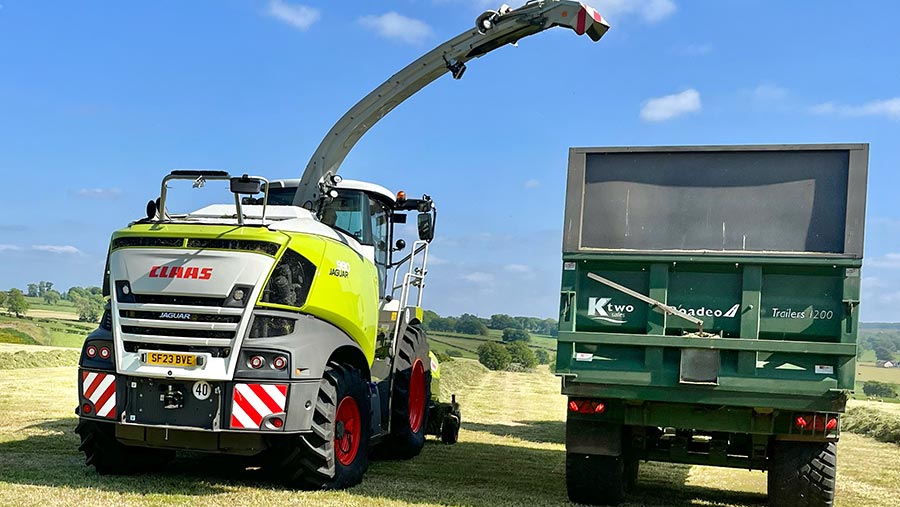 Retrofitting a grass plate transformed the Jaguar 980’s performance © Jim Watt
Retrofitting a grass plate transformed the Jaguar 980’s performance © Jim Watt It has been a harvest season of extremes for East Kilbride contractor Jim Watt, with a stonking first cut of silage preceding a stinking second.
But the decision to replace two Claas Jaguars, a 970 and 840, with a single 980 proved a shrewd move as the grass crops got heavier and the conditions more challenging.
“The season came quick – we basically skipped spring and went almost instantly from cold to warm and from drilling to silaging.
“That meant we were back to having some sensible-sized grass crops when we kicked off on 14 May, and it went rip-roaringly well.
See also: Contractor’s expense of wholecrop header softened by buying ex-demo model
About the contractor
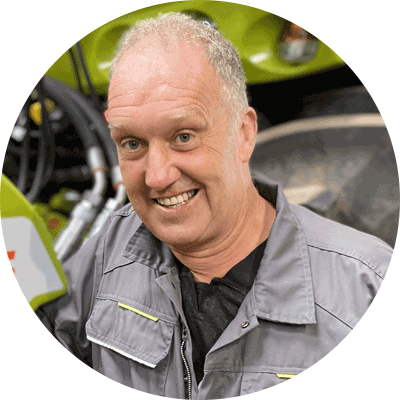
Jim Watt runs a 2,500ha silage, slurry and arable contracting business in East Kilbride
Kit list
- Tractors Fendt 724 x2, 720, 716, John Deere 6250R x2, 6155R
- Combines Claas Lexion 5500 with 25ft Convio header and Lexion 530 with 18ft Auto Contour
- Forager Claas Jaguar 980
- Balers McHale Fusion 4, Quadrant 5500 big baler, McHale 998 and Kuhn SW 4014 square bale wrappers
- Grass kit Disco 9200 butterfly x2 and 3200 front x2, Liner 2900 two-rotor and 4800 four-rotor rakes, Volto 1300 tedders x2, Einbock Grass-Manager harrow, Dalbo Maxiroll 630 flat rolls
- Slurry kit Slurrykat dribble bar and reelers, front-mounted compressor
- Handlers JCB 419S x2, TM320
- Sprayers and spreaders Knight 3,500-litre, 24m self-propelled, Kuhn Axis 40.2, Bunning Lowlander 105 x2
- Cultivators and drills Lemken Solitair 9+ 3m, Kverneland four-furrow ED85, Lemken power harrow 3m, Erth Panbuser 3m, Dalbo Levelfkex 2800 press, Dalbo Maxiroll 630 Cambrige rolls
- Main other kit Ktwo Roadeo 12t trailers x5, Iveco gritter lorry, BvL V-Mix 17-2S diet feeder, McConnel PA53E hedgecutter
Claas Jaguar 980 performance
“Initially, I didn’t think the 980 offered much more than the 970, but it came into its own as the crops thickened up.”
As well as being quieter and smoother, thanks partly to new feed roller dampers, the engine turned out to be surprisingly pokey.
“My biggest concern with the 980 was its V-formation engine. The old straight sixes had amazing torque backup and would always hang on to the death, whereas the V6 in the 970 tended to fall off a cliff.
“But the engine in the 980 coped just fine and throughput was no less than with the two machines last year.”
However, blowing light, fluffy crops into the trailers proved less than satisfactory due to a lack of draft in the discharge chute.
“A complaint was duly lodged with Claas, which suggested fitting a Hardox-lined grass plate at the base of the chute.
Rather than the standard flat panel, this forms a gradual wedge that, at its thickest point, protrudes by a couple of inches.
“It completely transformed the machine, to the point that I can’t fathom why it wouldn’t come as standard,” says Jim.
“And it’s not the first time I’ve had a situation like that. When I bought a Lexion 620 six years ago I found it impossible to get a clean sample. I spoke to the area rep – affectionately known as two mouths and one lug, as he has plenty to say and doesn’t do much listening – who suggested fitting TM6 sieves.
“The £2,000 upgrade was revolutionary. Anyone could set them up and, like with the forager grass plate, I found it incomprehensible that they were never standard.”
The relatively easy first cut was followed by a nightmare second, with wet weather resulting in terrible ground conditions.
“July was horrible – we were regularly having three days off and then one big, big day on, and hay was a complete non-event.”
Added to that, there was the continual challenge of sharing the road with cyclists and dog walkers.
“Our neighbourhood has an established cycling route and the lycra brigade causes havoc. We’re obliged to give them 3m of space but they don’t afford us the same luxury when we’re waiting in two-lane traffic and they want to nip through the gaps.
“We’ve also got a new housing estate nearby and are regularly having to get past dawdling people with a set of headphones on their head and a poodle wandering in the middle of the road.
“They’re usually oblivious to the fact that there’s a tractor with 12t of grass behind it until it’s a few feet from their backsides.”
First season for Fusion 4
The second new addition this year was a McHale Fusion 4, which replaced a pair of ageing Fusion 3s.
Again, switching from two machines to one caused few problems, largely thanks to major upgrades to the pick-up system.
“It is a tremendous improvement on what went before. The pick-up reel was always a problem because the crop had to take a slightly awkward route to the chamber.
“But they’ve got rid of the unnecessary gubbins, and it now guzzles the grass.”
It has been in hot demand too, churning out about 10,000 bales this year versus 8,000 from the Claas Quadrant and brace of square bale wrappers.
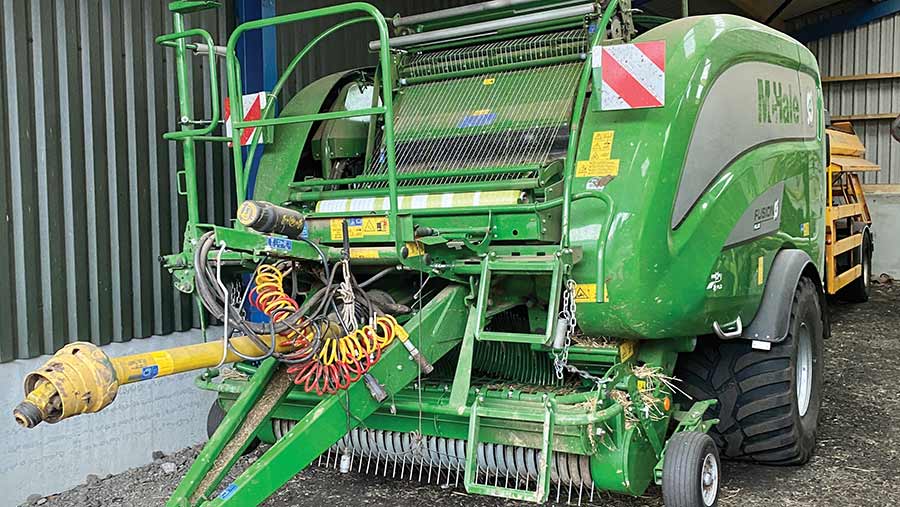
New arrival – the Fusion 4 has kicked out 10,000 bales this year © MAG/Oliver Mark
Much of this has been driven by the appeal of film-on-film wrapping, something Jim has a love-hate relationship with.
“Eighty percent of customers want film rather than net, mainly because the bales will happily store for a couple of years with no detriment to silage quality. For that, they’re happy to pay the 70p/bale premium.
“But it’s a finicky job and the film system got more troublesome as the season went on, either telling the driver it wasn’t wrapped when it was or, more annoyingly, kicking out unwrapped bales.
“Part of the problem is that the sensors get dirty – they may benefit from an air system to blow everything clean, like you’d get on baler knotters.
“This slows us down, but I can’t fault McHale’s service. The technicians know every last nut and washer.”
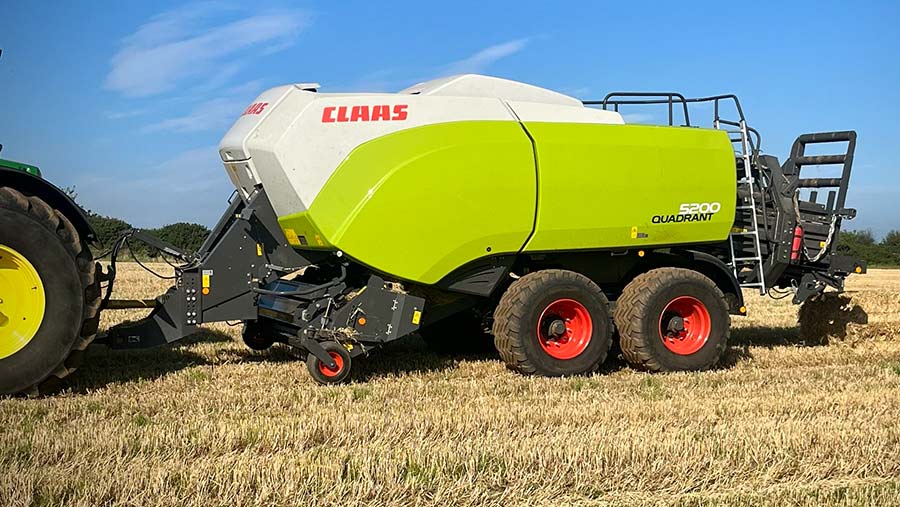
Claas Quadrant © Jim Watt
New wrapper
Despite the demand for round bale silage, Jim also decided to invest in a second square bale wrapper to work alongside the McHale 998 behind an acre-eating Claas Quadrant 5200.
“I’ve been pushing the squares because they’re easier and safer to stack and store.
“But the McHale has been troublesome – its design is too complicated, and we’ve had problems with the elevator chains snagging and snapping.”
With second-hand square bale wrappers hard to come by, Jim took up Kuhn’s offer of a SW 4014 demo – and, suitably impressed, subsequently bought it for £45,000.
“Like the McHale, it’s not great on hilly land, but it’s a far simpler design. With the two machines, we can just about keep on the tailgate of the Quadrant, which knocks out a phenomenal amount of grass.”
Meanwhile, the baler has once again proved faultless.
“Customers can’t believe the rate it can churn out bales without stopping, compared with others where the drivers spend as much time looking at the knotters as they do in the seat.”
Proceedings were only halted a couple of times due to breakdowns. One was caused by an errant stone that bent a needle and smashed a knotter casting; the other was self-inflicted.
“I caught an overhanging branch with the mower in its transport position, which bent the frame. Fortunately, Gordons [the local dealer] put it right.”
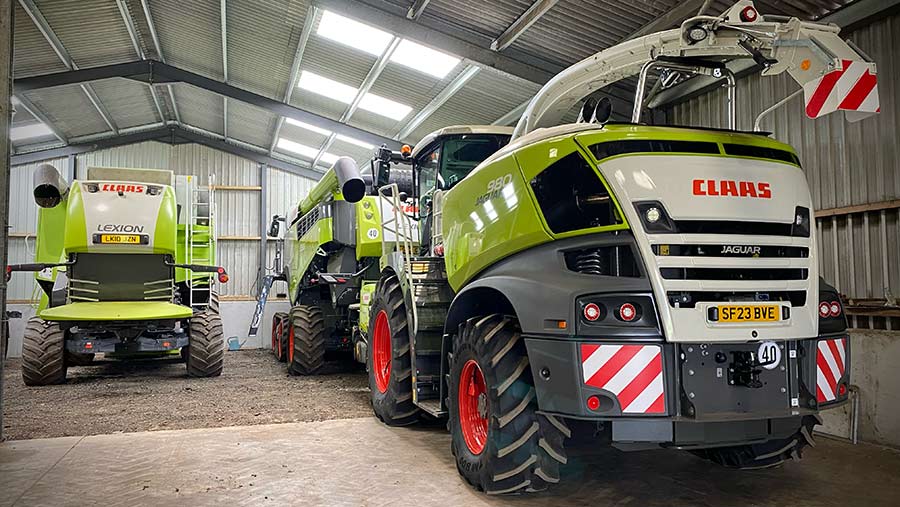
Forager and combines © Jim Watt
Shopping list
With this season drawing to a conclusion, thoughts inevitably turn to future investments.
Top of the wish list are replacements for the pair of highest-houred John Deere tractors – a 6155R and 6250R – which have just breached the 5,500-hour mark.
“The 6155R is a well-balanced tractor that suits us well, so I’d like to replace it with a 6R 185 if possible, as it’s basically the same but on steroids.
“And the 6250R has been a tremendous machine. There’s still good value in them but that starts to slide from 7,000-8,000 hours onwards, so I try to change them every three or four years.
“High-houred tractors are getting harder to sell – Ireland used to be a good market for them, but they seem to be buying new these days.
“And the price of new ones spooks me. A chap from Fendt came by recently to say he’d got an 828 in my spec, and I was interested… until he told me it would be £240,000.
“My bank manager would probably shoot me if I told him I was buying a quarter-of-a-million-pound tractor.
“But I have to trade that off with the value of keeping the fleet up to date. If I don’t, I’ll end up eating away at the residual value and, by the time I return to the market, I won’t be able to afford a new one.
“It may be that I go down the ex-hire route. That might knock £40,000 off the price – the downside is that the tractors will be configured to someone else’s liking, rather than my own.”
With four Fendts and two John Deeres in the fleet, Jim is also undecided on which brand to go for.
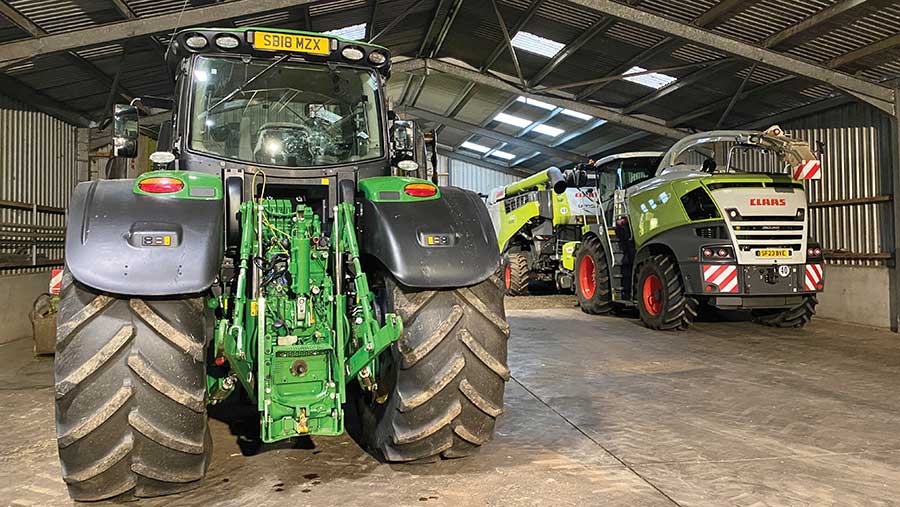
The John Deere 6250R might be next up for replacement © MAG/Oliver Mark
“Deere remains the benchmark for cab quality and ergonomics, but I wish they could get their cab suspension to the same level as Fendt.
“As I get older, I’m less keen on getting bounced around a tractor cab for 18 hours a day. The Deere just constantly rolls from side to side and bobs like a boat, so I’d pick the Fendt.
“The downside is that you need a good supply of cam shaft sensors and pto solenoids – the latter we now stock to save some hassle.”
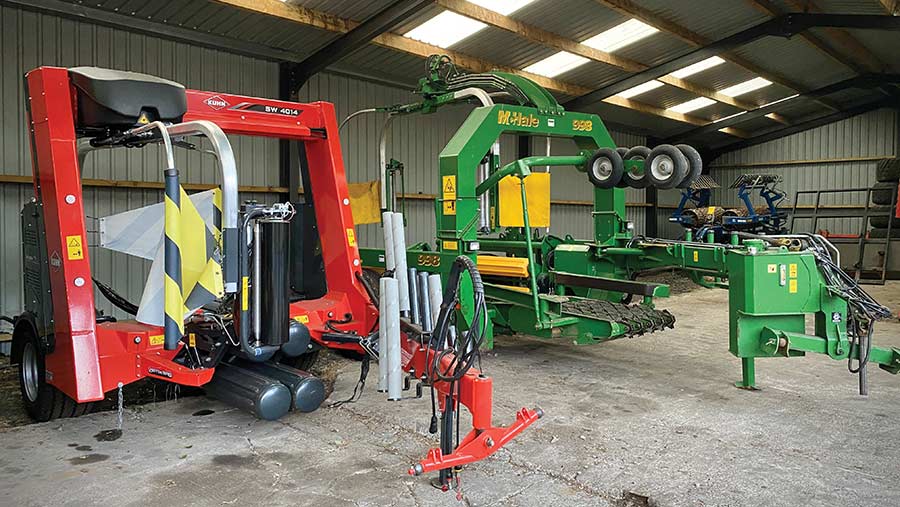
A Kuhn SW 4014 has joined the McHale 998 wrapper © MAG/Oliver Mark

